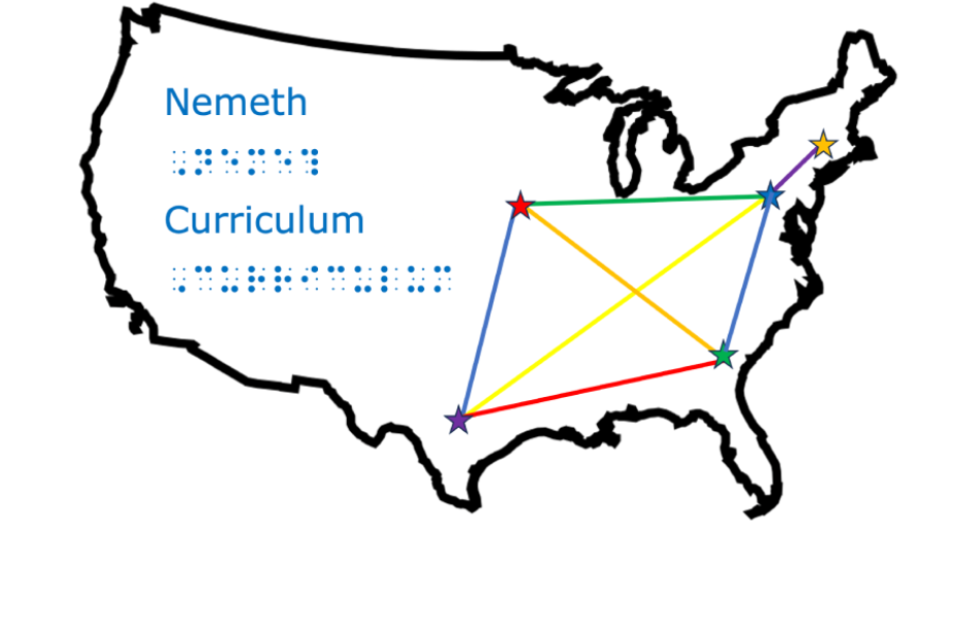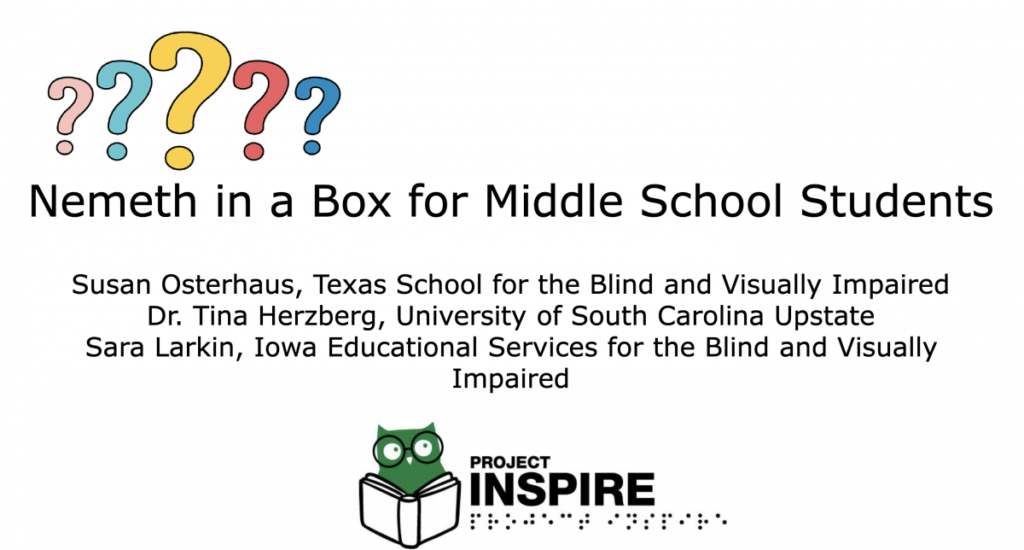By Tina Herzberg, Sara Larkin, and Susan Osterhaus
Acknowledgements
Proficiency in Nemeth Code is essential for accessing grade-level mathematics and science materials for K-16 students who are blind or low vision and read braille. The PreK to Second Grade Nemeth curriculum, Nemeth Focused Lessons, and Nemeth Symbol Library have been developed in partnership with the National Federation of the Blind (NFB) and Pearson’s Accessibility Team for School Assessment to increase proficiency of the Nemeth Code and reinforce grade-level mathematics concepts for students who are visually impaired. The project manager was Corey Fauble, and the curriculum team included: Dr. Tina Herzberg, Susan Osterhaus, and Sara Larkin with support from Carolyn Mason and Eric Guillory.
The authors wish to thank the:
- Members of the National Federation of the Blind, for their valuable feedback and recommendations about the PreK to Second Grade Nemeth Curriculum, Nemeth Focused Lessons, and Nemeth Symbol Library during user studies. We also appreciate NFB’s assistance in recruiting individuals to participate in user studies at their annual conventions from 2016 – 2018.
- American Printing House for the Blind for allowing us to reference their products and include information about how the various products could be used with the curriculum.
- Charlotte Cushman and Lisha Yochimowitz for webpage development so the curriculum is available on Paths to Literacy.
- Members of the Maryland Braille Task Force for Mathematics including Susan Adams, Dr. Michael J. Bina, Eldre Boggs, Melinda Demaris, Karen Ehrhardt Lloyd, Heather Johnson, Dr. Allison Layland, Jacqueline Otwell, Susan Polansky, Melissa Riccobono, Jill Richmond, Dr. Karen Ross, Carol Seckington, Sally Shreck, Linda Starner, and Lisa Wright. Their work on the Maryland Common Core State Curriculum Frameworks for Braille: Mathematics assisted us in aligning the Nemeth symbols by grade-level and served as a great resource as we have developed the curriculum!
- Knowbility for supporting our research efforts.
- Texas School for the Blind and Visually Impaired for their permission to use the Commonly Used Nemeth Mathematics Symbols Arranged by Grade and Course chart from the Texas School for the Blind and Visually Impaired publication “Nemeth at a Glance”.
The authors also wish to thank the following companies:
- Didax, Inc. the maker/distributor of Omnifix, Geostix, and other math products for allowing us to reference their products and how they can be used with the curriculum. Omnifix and Geostix materials with their tactile properties make them especially useful with students who are blind or low vision. Their teddy bear counters are good for developing beginning number concepts.
- E.A.S.Y. LLC for allowing us to reference their interactive tactile graphics products and include information about how they can be used with the curriculum. They provided inTACT Sketchpads and materials for the authors’ use when developing activities that incorporate tactile drawings. E.A.S.Y. shares our conviction that drawing is an essential part of tactile literacy for blind and low-vision students.
- Omnicor, Inc. the maker of Wikki Stix® and the Wikki Stix® STEM Pak for Math and Science for allowing us to reference their product and how they can be used with the curriculum. Wikki Stix® are especially useful when creating math tactile graphics or just fun tactile pictures.
- Uncle Goose for allowing us to reference their products and include information about how their products could be used with the curriculum. Their braille math blocks are a fun way to introduce and reinforce Nemeth braille numbers and math symbols.
- Wolf Products, Inc. the maker of the Math Window for allowing us to reference their products and how they can be used with the curriculum. The Math Window is an easy-to-use math teaching tool for blind and visually impaired students. Math problems are easily built, and changed as needed, using this movable braille method.
Bibliography
Our research sources include:
- Braille Authority of North America. (2010). Retrieved from: “Guidelines and standards for tactile graphics.”
- Braille Authority of North America. (2016). Retrieved from “Braille formats: Principles of print-to-braille transcripiton.” Braille formats: Principles of print-to-braille transcription.
- Braille Authority of North America. (2018). Retrieved from “Guidance for transcription using Nemeth Code within UEB contexts.”
- Cleveland, J., Bean, J., Bird, M., Kelley, S., O’Brien, S., Osterhaus, S., Sewell, D., & Torrence, G. (2016). Commonly used Nemeth mathematics symbols arranged by grade and course. In “Nemeth at a glance: A math resource, grade-level chart, and evaluation tool” (p. 59-83). Austin, TX: Texas School for the Blind and Visually Impaired.
- Common Core State Standards Initiative. (2010). Common Core State Standards for Mathematics. Washington, DC: National Governors Association Center for Best Practices and the Council of Chief State School Officers.
- Craig, R. (1987). “Learning the Nemeth Braille Code: A manual for teachers and students.” Louisville, KY: American Printing House for the Blind.
- Herzberg, T. S., & Rosenblum, L. P. (2014). “Print to braille: Preparation and accuracy of K-12 mathematics materials.” Journal of Visual Impairment & Blindness, 108, 355-367.
- International Council on English Braille. (2013). Retrieved from “The Rules of Unified English Braille (2nd ed.).”
- Maryland Department of Education. (2012). Retrieved from “Maryland Common Core State Curriculum frameworks for braille.”
- Maryland Department of Education. (2015). Retrieved from “Maryland College and Career Ready Standards for Unified English Braille.”
- Nemeth, A. (1972). “The Nemeth Braille Code for mathematics and science notation.” Louisville, KY: American Printing House for the Blind.
- NGSS Lead States. (2013). “Next generation science standards: For states, by states.” Washington, DC: The National Academies Press.
- Roberts, H., Krebs, B. M., & Taffet, B. (1978). “An introduction to braille mathematics.” Washington DC: Library of Congress.
- Rosenblum, P., & Smith, D. (2012). “Instruction in specialized braille codes, abacus, and tactile graphics at universities in the United States and Canada.” Journal of Visual Impairment & Blindness, 106(6), 339.
Return to Nemeth Braille Code Curriculum homepage.
- Nemeth Braille Code Curriculum
- About the Authors
- Acknowledgements and Bibliography
- Pre-K – Second Grade Nemeth Curriculum Materials
- Nemeth Focused Lessons
- Nemeth Symbol Library
- Nemeth Symbol Library Instructions
- Nemeth Symbol Library Settings
- Nemeth Symbol Library Tutorial
- Supplementary Materials: Commercially Available
- Frequently Asked Questions (FAQ)
- Nemeth Curriculum Support Request or Feedback


